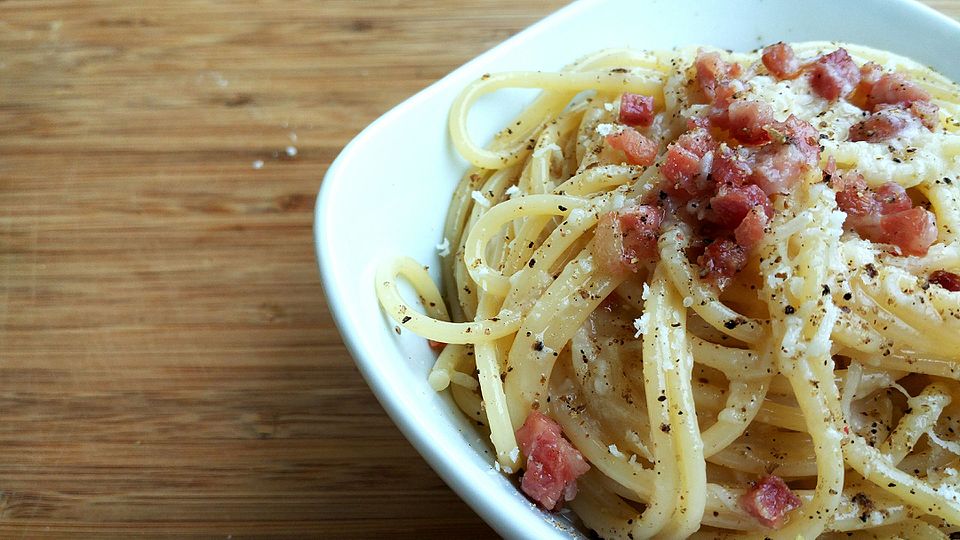Carbonara's Recipe
More Recipe
 Image: Spaghetti Alla Carbonara
Image: Spaghetti Alla Carbonara
Carbonara is a pasta dish made with fatty cured pork, hard cheese, eggs, salt, and black pepper.
It is typical of the Lazio region of Italy. The dish took its modern form and name in the middle of the 20th century.
The cheese is usually pecorino romano. Some variations use Parmesan, Grana Padano, or a combination of cheeses.
Spaghetti is the most common pasta, but bucatini or rigatoni are also used. While guanciale, a cured pork jowl, is traditional,
some variations use pancetta,and lardons of smoked bacon are a common substitute outside Italy.
The dish forms part of a family of dishes consisting of pasta with cured pork, cheese, and pepper, one of which is pasta alla gricia.
It is very similar to pasta cacio e uova, a dish dressed with melted lard and a mixture of eggs and cheese, but not meat or pepper.
Cacio e uova is documented as far back as 1839 and, according to researchers, anecdotal evidence indicates that some Italians born
before World War II associate that name with the dish now known as "carbonara".
Spaghetti Carbonara Ingredients
- Spaghetti: The pasta of choice for this dish.
- Guanciale (or Pancetta/Bacon): Cured pork cheek or a substitute like pancetta or bacon.
- Eggs: Used to create the creamy sauce, typically whole eggs or yolks.
- Pecorino Romano Cheese (or Parmesan): A hard, salty cheese, grated fresh for the best flavor.
- Black Pepper: Adds a spicy kick to the dish.
- Olive Oil
- Optional: Salt
Making The Carbonara Step By Step
- Step 1: Put a large saucepan of water on to boil.
- Step 2: Finely chop the 100g pancetta, having first removed any rind.
Finely grate 50g pecorino cheese and 50g parmesan and mix them together.
- Step 3: Beat the 3 large eggs in a medium bowl and season with a little freshly grated black pepper.
Set everything aside.
- Step 4: Add 1 tsp salt to the boiling water, add 350g spaghetti and when the water comes back to the boil,
cook at a constant simmer, covered, for 10 minutes or until al dente (just cooked).
- Step 5: Squash 2 peeled plump garlic cloves with the blade of a knife, just to bruise it.
- Step 6: While the spaghetti is cooking, fry the pancetta with the garlic.
Drop 50g unsalted butter into a large frying pan or wok and, as soon as the butter has melted, tip in the pancetta and garlic.
- Step 7: Leave to cook on a medium heat for about 5 minutes, stirring often, until the pancetta is golden and crisp.
The garlic has now imparted its flavour, so take it out with a slotted spoon and discard.
- Step 8: Keep the heat under the pancetta on low. When the pasta is ready, lift it from the water with a pasta fork or tongs and put it in
the frying pan with the pancetta. Don’t worry if a little water drops in the pan as well (you want this to happen) and don’t throw the pasta water away yet.
- Step 9: Mix most of the cheese in with the eggs, keeping a small handful back for sprinkling over later.
- Step 10: Take the pan of spaghetti and pancetta off the heat. Now quickly pour in the eggs and cheese.
Using the tongs or a long fork, lift up the spaghetti so it mixes easily with the egg mixture, which thickens but doesn’t scramble, and everything is coated.
- Step 11: Add extra pasta cooking water to keep it saucy (several tablespoons should do it). You don’t want it wet, just moist.
Season with a little salt, if needed.
- Step 12: Use a long-pronged fork to twist the pasta on to the serving plate or bowl. Serve immediately with a little sprinkling of the
remaining cheese and a grating of black pepper. If the dish does get a little dry before serving, splash in some more hot pasta water and the glossy sauciness will be revived.
Enjoy your delicious Spaghetti Carbonara!
